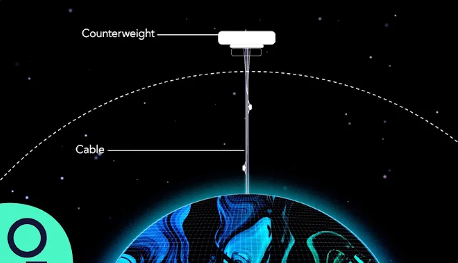Japan's Vision for the First Space Elevator by 2025
Written on
The Dream of a Space Elevator
The idea of a space elevator has long fascinated both scientists and science fiction fans. This ambitious concept, which proposes a colossal cable extending from the Earth's surface to a counterweight in space, has the potential to transform how we explore and access outer space. A Japanese company is now set to make this vision a reality.
Obayashi Corporation, a prominent construction firm in Japan, has unveiled plans to initiate the construction of a space elevator by 2025, aiming for it to be operational by 2050. If successful, this groundbreaking venture could significantly cut the costs and environmental impacts associated with space travel, paving the way for new opportunities in exploration, research, and even the collection of renewable energy from space.
In this detailed article, we will examine the complexities of Japan's space elevator project, discussing the technological hurdles, possible advantages, and the steps taken to bring this visionary idea to life. Join us on this expedition into the cosmos as we uncover Japan's remarkable journey to redefine how we venture beyond our planet.

The Mechanics of a Space Elevator
At its essence, the space elevator is a straightforward yet brilliant concept. It involves constructing a long, slender cable that reaches from the Earth's surface to a counterweight in geostationary orbit, about 36,000 kilometers (22,300 miles) above the planet. This cable, crafted from exceptionally strong and lightweight materials, would enable specialized vehicles known as "climbers" to ascend and descend, transporting people, cargo, and energy-generating equipment into space.
The notion of a space elevator has been around for decades, with early designs emerging in the 1960s. However, it was the discovery of carbon nanotubes in 1991 that sparked renewed interest. These tiny, tubular structures exhibit extraordinary strength and durability, making them ideal candidates for the elevator's tether.
Addressing the Technological Challenges
Constructing a space elevator presents numerous technological challenges, and Obayashi Corporation is acutely aware of these obstacles. One of the most significant is the immense length of the tether, which must stretch an astonishing 96,000 kilometers (59,651 miles). For context, the Earth's circumference is only about 40,000 kilometers (24,900 miles).
The tether must possess sufficient strength to endure the tremendous tension and forces acting on it while remaining lightweight enough for practical use. While carbon nanotubes theoretically meet these requirements, producing them in the necessary lengths and quantities remains a formidable challenge.
Moreover, the construction process itself requires meticulous planning. The tether and its supporting infrastructure must be assembled in stages, with materials transported to low-Earth orbit (LEO) by rocket before being positioned accordingly. This complex logistical effort demands precise coordination and the development of specialized tools and techniques.
The Multi-Stage Construction Approach
Obayashi's construction plan includes multiple stages, beginning with the transportation of materials and components to low-Earth orbit. From there, a spacecraft will lower the carbon nanotube cable to the Earth's surface, gradually building the necessary tension and length over several months.
Once the initial tether is established, the team will work on reinforcing and strengthening the structure. This process involves specialized climbers ascending the tether and carrying additional cables and materials to create a robust, layered system capable of supporting the weight of future payloads.
As the tether reaches its full length of 96,000 kilometers, a counterweight will be placed at the top to provide the necessary balance and stability. Following this, the focus will shift to constructing the “Earth Port,” which will serve as the entry and exit point for the elevator's climbers.

The Advantages of a Space Elevator
Successfully building a space elevator could dramatically change the way we access and utilize space. One of the most significant benefits of this technology is the potential decrease in the cost of space travel.
Traditional rocket launches are notoriously expensive. For instance, NASA estimates that its Artemis missions to the Moon could cost around $4.1 billion per launch. In contrast, Obayashi Corporation believes that sending a climber into space via the elevator could cost only a few thousand dollars, making space exploration and research more accessible to diverse organizations and individuals.
Additionally, the space elevator's climbers would utilize renewable energy sources like solar power or microwaves, eliminating the need for onboard fuel and its associated environmental impacts. This positions the space elevator as a far more sustainable alternative to traditional rocket launches, which contribute significantly to greenhouse gas emissions and other pollutants.
The Space Solar Power System (SSPS)
One of the most captivating aspects of Obayashi's space elevator project is its potential to transform renewable energy generation and distribution. The company's plans include deploying a Space Solar Power System (SSPS) satellite at an altitude of 36,000 kilometers, where it would gather solar energy and transmit it to receiving antennas on Earth.
Unlike terrestrial solar power systems, the SSPS would not be affected by weather or day-night cycles, ensuring a consistent and reliable renewable energy source. The collected energy would be sent to antennas located over oceans using wireless power transmission.
This innovative approach could significantly impact the world's growing energy demands while reducing reliance on fossil fuels and non-renewable resources.
The Importance of Global Collaboration
Given the scale and complexity of the space elevator project, Obayashi Corporation recognizes the necessity of international collaboration and partnerships. The company is working closely with the Japan Aerospace Exploration Agency (JAXA) and the Ministry of Education, Culture, Sports, Science and Technology Japan (MEXT) to advance essential research and development efforts.
Beyond domestic partnerships, Obayashi aims to engage with organizations and experts worldwide. The company is actively involved in the European Space Elevator Challenge (EUSPEC), which gathers university students and researchers to design and test scaled-down models of space elevator climbers.
This global cooperation is vital, as the project requires expertise across various fields, including materials science, aerospace engineering, robotics, and legal frameworks. By fostering these collaborative efforts, Obayashi hopes to overcome the many challenges and bring the space elevator concept to fruition.
The Role of the Aoki Laboratory
A key contributor to Obayashi's space elevator project is the Aoki Laboratory, led by Professor Yoshio Aoki at Nihon University’s Department of Precision Machinery Engineering. The laboratory has played an essential role in developing critical components, such as the tether-deployment mechanism and climber design.
The team, known as “Team Raptor,” has participated in all iterations of the EUSPEC competition, consistently showcasing their expertise in strength calculations, durability, and safety. In the 2018 competition, Team Raptor achieved overall victory in the Advanced Class and earned awards for their contributions in safety, construction quality, and innovation.
The Aoki Laboratory's involvement extends beyond EUSPEC, as they are also collaborating with Shizuoka University and Obayashi Corporation on the STARS-Me (Space Tethered Autonomous Robotics Satellite-Mini elevator) project, focusing on developing a small-scale climber prototype that can traverse a tether linking two CubeSats (small satellites).
The Project Timeline and Future Milestones
Obayashi Corporation's initial timeline for the space elevator project is ambitious, with plans to begin construction by 2025 and potentially have the system operational by 2050. However, the company acknowledges that these timelines may need adjustments as the project evolves and unforeseen challenges arise.
According to Yoji Ishikawa from Obayashi’s future technology creation department, the current focus is on "research and development, rough design, partnership building, and promotion" rather than immediate construction. This suggests the 2025 start date may be delayed as the team continues refining technical and logistical aspects.
Despite potential delays, Obayashi remains dedicated to the space elevator vision, viewing it as a “new kind of public works project that would benefit all of humankind,” with the ability to revolutionize space exploration, energy generation, and transportation.
Ongoing Research and Development Initiatives
Although the space elevator may not be immediately ready for construction, research and development are actively progressing. Obayashi Corporation collaborates with partners like JAXA and MEXT to advance necessary technologies and overcome challenges.
A key focus is developing carbon nanotube materials for the elevator's tether. Researchers aim to produce these microscopic structures in sufficient quantities and lengths, as current capabilities fall short of requirements.
The team is also concentrating on designing and testing climber vehicles capable of ascending and descending the space elevator. These specialized systems must handle heavy payloads, maintain high speeds, and navigate the tether's complex environment.
The Aoki Laboratory's work on the STARS-Me project, which involves creating a small-scale climber prototype, is a crucial step in this process, allowing researchers to test and refine the technologies essential for a full-scale space elevator.

Transforming Space Exploration and Research
Successfully deploying a space elevator could profoundly impact the future of space exploration and research. By dramatically lowering the costs and environmental impacts of accessing space, the elevator could create new opportunities for various organizations and individuals to engage in space activities.
One exciting possibility is its potential to facilitate the exploration of other planets, such as Mars. Estimates suggest a space elevator could reduce travel time to Mars from the current six to eight months down to as little as 40 days, making interplanetary travel far more feasible.
Moreover, the space elevator's capacity for transporting large payloads into orbit could enable the construction of extensive space infrastructure, such as orbital research stations, manufacturing facilities, and even space-based solar power generation systems. This could lead to breakthroughs in diverse fields, including materials science, medicine, energy production, and climate research.
Wider Implications for Humanity
Beyond immediate benefits to space exploration and research, successfully developing a space elevator could have far-reaching implications for humanity's future. By reducing barriers to space access, the elevator could catalyze a new era of innovation, collaboration, and global cooperation.
The ability to transport people and resources into space more efficiently and affordably could lead to permanent human settlements beyond Earth, paving the way for colonizing the Moon, Mars, and potentially even further. This could have profound implications for the long-term survival and expansion of the human species as we explore and harness resources within our solar system.
Additionally, the space elevator's potential to change renewable energy generation could significantly contribute to global efforts to address climate change and secure a sustainable future. Harnessing abundant solar energy in space could provide a clean, reliable, and scalable solution to the world's growing energy needs, reducing dependence on fossil fuels and other non-renewable resources.
Aiming for the Stars
The space elevator project embodies an ambitious vision for humanity's future in space exploration and technological advancement. Led by Obayashi Corporation and supported by a diverse range of international partners, this initiative pushes the boundaries of what is achievable, utilizing cutting-edge materials science, engineering, and renewable energy technology to redefine how we access and exploit the vastness of space.
While the challenges ahead are formidable, the potential rewards are equally transformative. By making space travel more affordable, sustainable, and accessible, the space elevator could unlock new avenues for scientific discovery, technological innovation, and the expansion of human civilization beyond Earth.
As we envision the future, the space elevator stands as a testament to human ingenuity and determination. It symbolizes our unyielding quest to explore, push the limits of the possible, and reach for the stars. With the unwavering commitment of Obayashi Corporation and its partners, the dream of a space elevator may soon materialize, heralding a new era of space exploration and a brighter, more sustainable future for humanity.